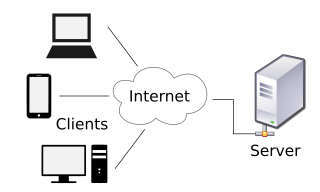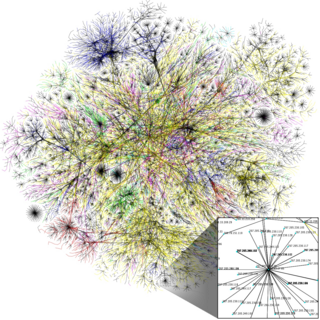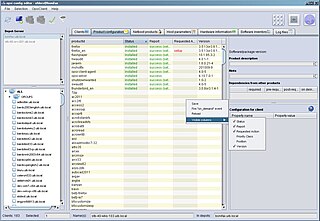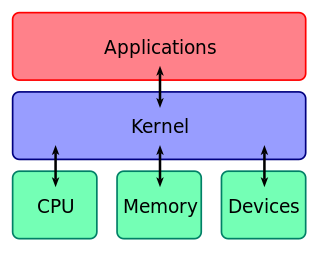
In computing, BIOS is firmware used to perform hardware initialization during the booting process, and to provide runtime services for operating systems and programs. The BIOS firmware comes pre-installed on a personal computer's system board, and it is the first software to run when powered on. The name originates from the Basic Input/Output System used in the CP/M operating system in 1975. The BIOS originally proprietary to the IBM PC has been reverse engineered by some companies looking to create compatible systems. The interface of that original system serves as a de facto standard.

Client–server model is a distributed application structure that partitions tasks or workloads between the providers of a resource or service, called servers, and service requesters, called clients. Often clients and servers communicate over a computer network on separate hardware, but both client and server may reside in the same system. A server host runs one or more server programs, which share their resources with clients. A client usually does not share any of its resources, but it requests content or service from a server. Clients, therefore, initiate communication sessions with servers, which await incoming requests. Examples of computer applications that use the client–server model are email, network printing, and the World Wide Web.

Free software is computer software distributed under terms that allow users to run the software for any purpose as well as to study, change, and distribute it and any adapted versions. Free software is a matter of liberty, not price; all users are legally free to do what they want with their copies of a free software regardless of how much is paid to obtain the program. Computer programs are deemed "free" if they give end-users ultimate control over the software and, subsequently, over their devices.

A web server is computer software and underlying hardware that accepts requests via HTTP, the network protocol created to distribute web pages, or its secure variant HTTPS. A user agent, commonly a web browser or web crawler, initiates communication by making a request for a specific resource using HTTP, and the server responds with the content of that resource or an error message. The server can also accept and store resources sent from the user agent if configured to do so.

Configuration management (CM) is a systems engineering process for establishing and maintaining consistency of a product's performance, functional, and physical attributes with its requirements, design, and operational information throughout its life. The CM process is widely used by military engineering organizations to manage changes throughout the system lifecycle of complex systems, such as weapon systems, military vehicles, and information systems. Outside the military, the CM process is also used with IT service management as defined by ITIL, and with other domain models in the civil engineering and other industrial engineering segments such as roads, bridges, canals, dams, and buildings.
Interoperability is a characteristic of a product or system, whose interfaces are completely understood, to work with other products or systems, at present or in the future, in either implementation or access, without any restrictions. While the term was initially defined for information technology or systems engineering services to allow for information exchange, a broader definition takes into account social, political, and organizational factors that impact system-to-system performance. Hence, interoperability involves the task of building coherent services for users when the individual components are technically different and managed by different organizations. Types of interoperability include syntactic interoperability, where two systems can communicate with each other, and cross-domain interoperability, where multiple organizations work together and exchange information. In any collaborative effort, cross-domain interoperability is important because a lack of communication can cause misunderstandings and greatly reduce efficiency. This would especially be a problem in organizations that are meant to respond to emergencies as quickly as possible, such as law enforcement, fire fighting, EMS, and other public health and safety departments.
Key management refers to management of cryptographic keys in a cryptosystem. This includes dealing with the generation, exchange, storage, use, crypto-shredding (destruction) and replacement of keys. It includes cryptographic protocol design, key servers, user procedures, and other relevant protocols.

Online shopping is a form of electronic commerce which allows consumers to directly buy goods or services from a seller over the Internet using a web browser or a mobile app. Consumers find a product of interest by visiting the website of the retailer directly or by searching among alternative vendors using a shopping search engine, which displays the same product's availability and pricing at different e-retailers. As of 2020, customers can shop online using a range of different computers and devices, including desktop computers, laptops, tablet computers and smartphones.
Microsoft Dynamics AX was one of Microsoft's enterprise resource planning software products. It is part of the Microsoft Dynamics family. In 2018, its thick-client interface was removed and the web product was rebranded as Microsoft Dynamics 365 for Finance and Operations as a part of Microsoft's Dynamics 365 suite.
Field service management (FSM) refers to the management of a company's resources employed at or en route to the property of clients, rather than on company property. Examples include locating vehicles, managing worker activity, scheduling and dispatching work, ensuring driver safety, and integrating the management of such activities with inventory, billing, accounting and other back-office systems. FSM most commonly refers to companies who need to manage installation, service, or repairs of systems or equipment. It can also refer to software and cloud-based platforms that aid in field service management.

ArcGIS is a family of client software, server software, and online geographic information system (GIS) services developed and maintained by Esri. ArcGIS was first released in 1999 and originally was released as ARC/INFO, a command line based GIS system for manipulating data. ARC/INFO was later merged into ArcGIS Desktop, which was eventually superseded by ArcGIS Pro in 2015. ArcGIS Pro works in 2D and 3D for cartography and visualization, and includes Artificial Intelligence (AI).

The Reynolds and Reynolds Company is a private corporation based in Dayton, Ohio. Its primary business is providing business forms, management software and professional services to car dealerships. Its software is used to manage sales logistics at dealerships. It also produces forms used in medicine and insurance.
Geospatial metadata is a type of metadata applicable to geographic data and information. Such objects may be stored in a geographic information system (GIS) or may simply be documents, data-sets, images or other objects, services, or related items that exist in some other native environment but whose features may be appropriate to describe in a (geographic) metadata catalog.

Intel Active Management Technology (AMT) is hardware and firmware for remote out-of-band management of select business computers, running on the Intel Management Engine, a separate microprocessor not exposed to the user, in order to monitor, maintain, update, upgrade, and repair them. Out-of-band (OOB) or hardware-based management is different from software-based management and software management agents.

Opsi is a software distribution and management system for Microsoft Windows clients, based on Linux servers. Opsi is developed and maintained by uib GmbH from Mainz, Germany. The main parts of Opsi are open-source licensed under the GNU Affero General Public License.

The kernel is a computer program at the core of a computer's operating system and has complete control over everything in the system. It is the "portion of the operating system code that is always resident in memory", and facilitates interactions between hardware and software components. A full kernel controls all hardware resources via device drivers, arbitrates conflicts between processes concerning such resources, and optimizes the utilization of common resources e.g. CPU & cache usage, file systems, and network sockets. On most systems, the kernel is one of the first programs loaded on startup. It handles the rest of startup as well as memory, peripherals, and input/output (I/O) requests from software, translating them into data-processing instructions for the central processing unit.
Inventory management software is a software system for tracking inventory levels, orders, sales and deliveries. It can also be used in the manufacturing industry to create a work order, bill of materials and other production-related documents. Companies use inventory management software to avoid product overstock and outages. It is a tool for organizing inventory data that before was generally stored in hard-copy form or in spreadsheets.
Software categories are groups of software. They allow software to be understood in terms of those categories, instead of the particularities of each package. Different classification schemes consider different aspects of software.
Tool management is needed in metalworking so that the information regarding the tools on hand can be uniformly organized and integrated. The information is stored in a database and is registered and applied using tool management. Tool data management consists of specific data fields, graphics and parameters that are essential in production, as opposed to managing general production equipment.










